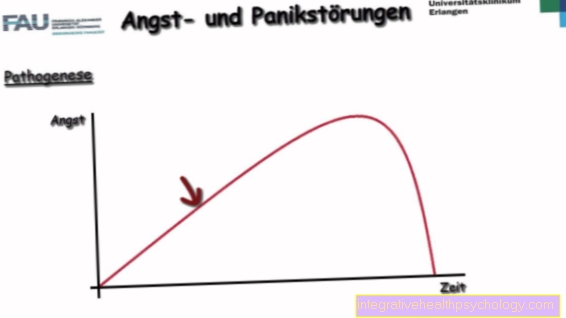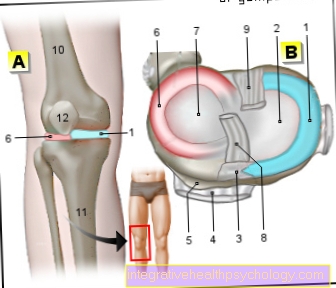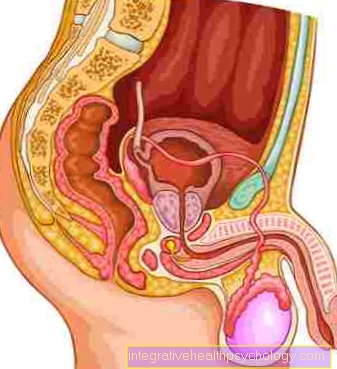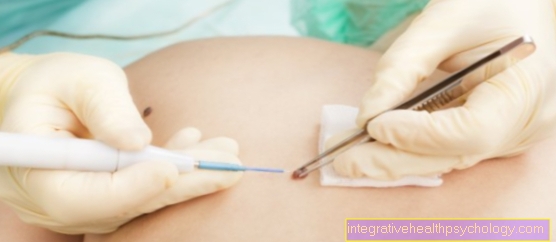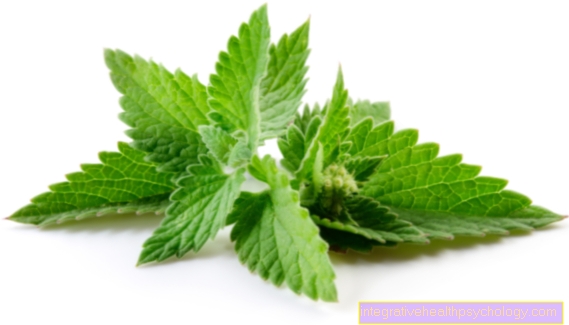Quick value
What's the Quick Value?
The Quick value is a laboratory value for checking blood clotting and is also given with the words Prothrombin time or Thromboplastin time (TPZ) circumscribed. Blood clotting is an essential function of the body to stop bleeding and consists of a primary and a secondary part.
The primary part of blood clotting causes the formation of a network of platelets (Platelets). The secondary part consists of mutually activating coagulation factors in a chain reaction, which as an end point cause the conversion of a soluble precursor, fibrinogen, into insoluble fibrin. Fibrin is a protein and can also be compared to an adhesive that connects the individual components of blood clotting.
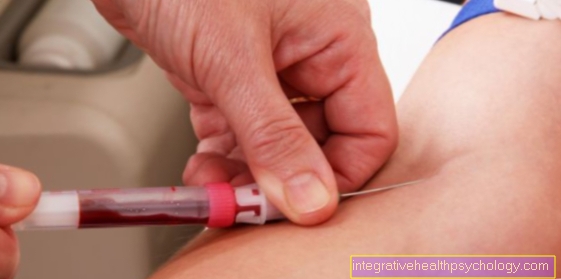
The blood clotting chain reaction possessed by humans two ways to activate it. For one thing is the exogenous way to name, which arises from endothelium injury (endothelium = the inner lining of the blood vessels) of the blood vessels, on the other hand there is the endogenous way, which is mainly caused by activated blood platelets.
Of the Quick value is used to monitor the extrinsic system and indicates the duration of its activation, in percent (unit%), until the formation of fibrin compounds. The duration of the clotting time is calculated in the Quick value using a standard value as a percentage of the standard. If the coagulation time is prolonged, a lowered Quick value is shown.
- Platelets
- Blood clotting
What is the Quick value used for in medicine?
The quick value is a important diagnostic marker for checking blood clotting. This is an important component during operations, for example, because if it does not work properly, prolonged bleeding is possible, which can result in blood loss. For this purpose, it may be necessary to stop taking blood-thinning medication before planned surgery.
The Quick value is also used for Detection of a lack of vitamin K.. This vitamin is important for the function of some coagulation factors, which cannot function without it. On the other hand, this property of the coagulation factors is also a point of attack for drugs that are supposed to prolong blood clotting. For this you use drugs such as Marcumar®, which is an opponent of vitamin K and thus the Delays blood clotting. Prolonged blood clotting may be desirable in several scenarios, such as after heart attacks, to Strokes or after Installation of artificial heart valves to prevent uncontrollable blood clotting.
In diseases of the liver, such as hepatitis or Cirrhosis of the liver, it can lead to disturbances in the production of coagulation factors. By monitoring the Quick value, it is then possible to weigh up possible therapy strategies and to react to the deficiency.
- Vitamin K
- Marcumar®
How does the Quick differ from the INR?
Of the INR value (International Normalized Ratio) represents a standardized variant of the Quick value, which provides better comparability of the values across all laboratories and is therefore subject to lower fluctuations depending on the laboratory. For this reason, the INR value is increasingly replacing the Quick value in everyday clinical practice. In comparison, an increased INR value indicates a longer coagulation time. With the Quick value, the percentage decreases with the prolonged duration of blood clotting. This can initially lead to confusion for the layperson. In general So if the INR value detects the same properties of the blood coagulation system as the Quick, it is simply more comparable through standardization. In various test procedures, the Quick value simply showed different results that were difficult to compare with one another. The standard value of the INR is 1.0. If the coagulation time is prolonged, for example with anticoagulant therapy for the prophylaxis of a thrombosis, the value is between 2.0 and 3.5.
Read more about the topic here: INR
What if the quick is too high?
The Quick value reflects the duration of the clotting time of a normal value in the normal population and is calculated as a percentage. For one well-functioning coagulation should he greater than 70% be. Unusually for percentage values, the Quick can also exceed 100%, which is why the standard value in the literature of 70-130% is given. Basically, too high a Quick value, i.e. a fast coagulation time, has no disease value.
The Quick detects the extrinsic side of the coagulation chain reaction, which can be triggered by vascular injuries. Reliable, fast coagulation is a good prerequisite for preventing bleeding. Dangers arise if the Quick value is too low. If the therapeutic effect is desired, this is below 70%, or lower depending on the desired target value. If the desired Quick is well below the target, this means a much longer coagulation time, which can result in complications such as bleeding.
What are the causes of too low Quick values?
The cause of too low Quick values can be a Synthesis disorder of the liver be evoked. The liver produces all important coagulation factors that are essential for blood clotting. Thus, patients who participate in a Cirrhosis of the liver are ill, suffer complications such as bleeding, since cirrhosis of the liver is to be understood as a scarred remodeling of the liver tissue, which is accompanied by an irreversible loss of function.
Another cause of a too low Quick value can be a Overdose with anticoagulant drugs be like Marcumar®. Marcumar® prevents the contact with vitamin K, which is important for the coagulation factors. It follows that the vitamin K-dependent coagulation factors cannot activate each other, which leads to a longer bleeding time and thus to a reduced Quick value. In order to avoid this, drugs have been developed which more specifically inhibit only individual coagulation factors and show fewer interactions with other drugs. These drugs also have fewer complications and are very easy to neutralize in the event of an overdose.
What should the Quick value be with Marcumar®?
Marcumar® is a drug which Prevents activation of certain coagulation factors by neutralizing vitamin K. How the quick should be during a treatment with Marcumar® depends entirely on the individual reason for the therapy. Generally one tries due to the extended clotting time under Marcumar®, Thrombosis and resulting To prevent embolism.
So if events such as thrombosis, pulmonary embolism, heart attack or stroke have occurred in the past, therapy with Marcumar® can be considered. The target range is then a Quick of 22-37% (INR 2-3). This is also the range to be achieved in the presence of atrial fibrillation of the heart. After installing a mechanical heart valve, the quick should then be between 18 and 28% (INR 2.5-3.5). In principle, the blood coagulation parameters must be checked regularly in order to prevent possible complications such as bleeding. Basically, it has to be said that newer drugs show better controllability of the anticoagulant so that fewer controls are required.
- Effect of Marcumar®
- Side effects of Marcumar®
- Detect thrombosis
Orientation values after certain treatments
- after thrombosis
- Quick target value 22-37%
- INR value 2-3
- after pulmonary embolism
- Quick target value 22-37%
- INR value 2-3
- with atrial fibrillation
- Quick target value 22-37%
- INR value 2-3
- with mechanical heart valve replacement
- Quick target value 18-28%
- INR value 2.5 - 3.5
- Thromboembolism prophylaxis after knee and hip replacement
- Quick target value 22-37%
- INR value 2-3
Basically it has to be repeated again that the Quick value due to inaccuracies and strong fluctuations in the measurement results, hardly any use and has instead been replaced by the INR value.
What should the Quick value be before a tooth extraction?
In dentistry, the removal of a tooth without major surgery is called tooth extraction. In general, it can be said that bleeding can occur with every tooth extraction, as the tooth is well anchored in the gums that are well supplied with blood. In the normal case, with a Quick of 70 to 100% (INR 1), the pressure of a swab is enough for about 5 to 10 minutes to stop this small bleeding. If the coagulation situation changes, it is important to work with the treating family doctor to find a way to carry out the necessary tooth extraction. The German Society for Dental, Oral and Maxillofacial Medicine recommends checking the Quick or INR value on the day of treatment, but does not rule out INR values of 2.0 to 3.5 (Quick value 18-37%) under adequate hemostatic measures .
How is the Quick value measured?
The measurement of the Quick value takes place after Decrease in venous blood in a special tube that contains citrate. Citrate causes an immediate dissolution of calcium, an important part of blood clotting. The blood is warmed to body temperature in the laboratory and the same amount of calcium added as was previously dissolved. Now the coagulation is activated by adding substances and the Measured time to blood clot onset. Once the time has been set for the blood drawn, it will in relation at the clotting time of the blood healthy normal population set. Since different aids are used in the different laboratories, it is possible that the results are different in comparison, so that the Quick value is converted into the standardized INR value.
Quick value measuring device for the home
Since the control of the required Quick value always requires an adjustment of the dosage when taking Marcumar®, regular controls are essential. This adjustment is necessary because Marcumar® because of his pharmacological properties in interaction with various drugs can occur, which trigger an increase or decrease in the effect. To ensure close control of the Quick value in responsible patients, measuring devices can also be used in the home. The more closely the value is monitored, the better the dose can be adjusted and the fewer complications there are. In order to carry out the measurement as a layperson at home, extensive training is necessary. These then make it possible to go on longer trips without having to look for a doctor on site for a laboratory check.
Does the health insurance pay for that?
The Training and equipment costs are initially a considerable expense for the health insurance companies, which is why resistance is often to be expected. Nevertheless, there are many reasons in favor of home self-measurement, because it can prevent many complications such as bleeding or strokes, which in turn entail higher costs. So you shouldn't get discouraged if your health insurance initially rejects it. In any case, what speaks in favor of self-measurement is that patient satisfaction is increased, since a conscientious co-determination of the therapy can take place here.





